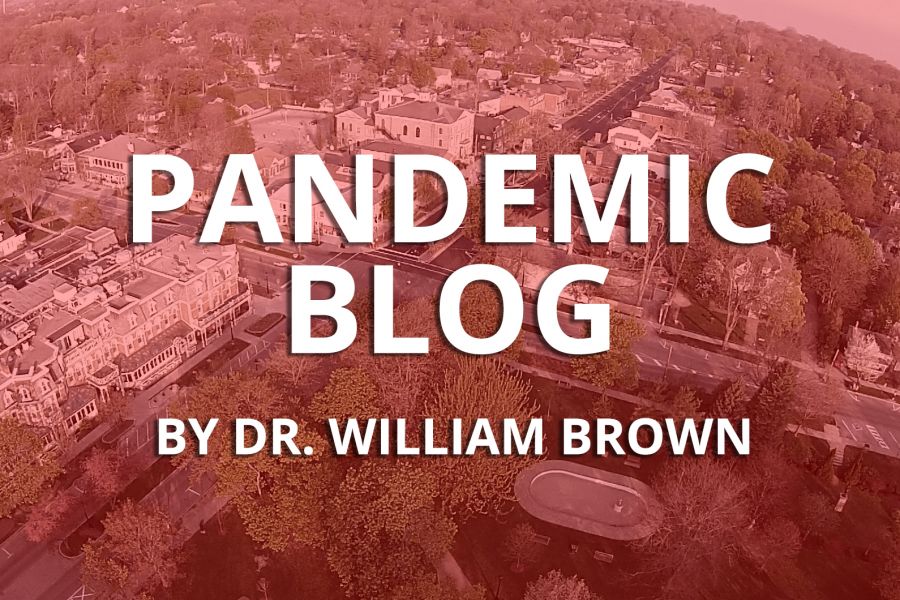Dr. William Brown
Special to The Lake Report
I recently wrote an article in this paper about priorities in the face of limited technical and human resources in this pandemic.
Those decisions were and are being made on the fly, in a pandemic where we’re still learning about the biology of the SARS-COV-2 virus (commonly known as COVID-19) and important questions remain unanswered.
Does exposure to the virus confer lasting immunity, for the young, the old, if not, for how long? And, related to that question, what’s the most effective test for revealing the presence of antibodies, which indicate previous exposure to the virus?
When will an effective long-lasting vaccine be widely available in sufficient quantities to protect millions of those at risk, those now in quarantine, front-line health care providers and the wider public?
What’s the most effective test for detecting those carrying the virus? When will such tests become freely and widely available?
What are the most effective tools for identifying those patients, most at risk for developing severe complications? What are the long-term consequences for those who recover from COVID-19 infections?
Is there any evidence that the virus has mutated to become more lethal in the course of this pandemic, and if so, where and what might those mutations be? Why is the disease so lethal for older patients and those with chronic medical conditions such as hypertension, heart disease, diabetes and chronic lung diseases – and conversely why, except for a few, are the young spared? All excellent questions awaiting answers.
One of the most pressing challenges associated with this pandemic, is the way it has devastated long-term care facilities such as retirement homes, assisted living facilities and homes populated with patients with neurodegenerative diseases such as the dementias in all their forms.
The experience in much of Europe, the United Kingdom, New York City and now Canada highlight these challenges. For example, the Globe and Mail’s headline on April 14 was, “Nearly half of virus deaths linked to long-term care centres.” The number of COVID-19 related deaths is staggering but not surprising.
This virus is highly infectious and most long-term care facilities simply don’t have the staff to promote or enforce social distancing, given the closed space nature of most facilities where most elderly patients are warehoused these days.
Once the COVID-19 infection reaches the wider community it’s very difficult, even in a lockdown situation where visitors, including spouses, are prevented from visiting patients, to prevent the virus gaining access to the closed, highly vulnerable community without effective testing.
The problem is that what has passed for testing staff and others at risk for bringing the virus into the facilities is a questionnaire about symptoms and looking for a fever. That just isn’t sensitive enough. The reason is that infected people, especially the young, often have no symptoms or fever for five to 14 days, during which they can infect others and contaminate surfaces.
The best test is a nose/throat swab to detect the RNA signature of the virus. That’s what works. Unfortunately, because of poor planning in Europe and now North America, that kind of repeated on-the-job testing isn’t available. So, unless all caregivers and, for that matter, anyone with indirect access such as administrative staff and others for example delivering supplies, are regularly tested for the virus, facilities have no effective way of knowing who’s infected and who isn’t.
Without that kind of testing, it’s only a matter of time before this virus gains a hold in the petri-dish like patient communities characteristic of most long-term care facilities. We certainly can’t blame the long-term care facilities for testing failures and hence this virus gaining a hold.
Most long-term care facilities were never designed, nor the staff trained, for the extraordinary challenges presented by this virus. Unfortunately for patients and perhaps some staff, there will be more deaths before this is over.
We were warned that this might happen by earlier encounters with coronaviruses, including SARS-COV1 and MERS, and the international community should have been better prepared for this disaster around the world. Rest assured more pandemics will follow, potentially far worse, especially if whatever the virus is attacks all age groups.
* Full disclosure: my wife has dementia and lives in a long-term care facility in Niagara-on-the -Lake. My experience has been that the staff are excellent – underpaid and overworked for what from my observations is a very difficult job, now made far worse by this disease which poses a real risk to them, the same way other health care workers may be at risk.
Dr. William Brown is a professor of neurology at McMaster University and co-founder of the Infohealth series held on the second Wednesday of each month at the Niagara-on-the-Lake Public Library.










